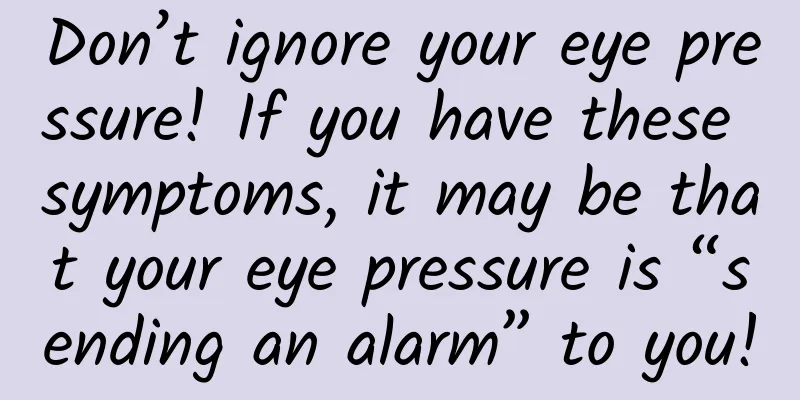Don’t ignore your eye pressure! If you have these symptoms, it may be that your eye pressure is “sending an alarm” to you!

|
1. What is intraocular pressure? Intraocular pressure refers to the pressure inside the eyeball, referred to as intraocular pressure. Under normal circumstances, intraocular pressure is maintained within a certain range (11-21 mmHg), which is crucial to eye health. Huaihua Aier Eye Hospital reminds: If intraocular pressure rises abnormally, it may cause a series of symptoms and hazards, including mild and severe manifestations. 2. Symptoms of high intraocular pressure (1) Mild high intraocular pressure 1. Blurred vision : Mild high eye pressure may cause blurred vision, especially after reading or using a computer. 2. Eye discomfort : You may experience soreness in the eyes or discomfort at the root of the nose. 3. Red bloodshot eyes : High intraocular pressure may put pressure on the blood vessels inside the eyes, causing obstructed blood circulation and the appearance of red bloodshot eyes. (2) Severe intraocular pressure 1. Eye pain : Increased intraocular pressure can cause pressure and damage to the nerves and retina inside the eyeball, leading to eye pain. 2. Headache : A sharp increase in intraocular pressure may stimulate the trigeminal nerve endings and cause migraine. 3. Nausea and vomiting : Increased intraocular pressure can reflexively cause excitement of the vagus nerve and vomiting nerve center, leading to nausea and vomiting. 4. The eyeball becomes hard : As the intraocular pressure rises further, the eyeball may feel hardened, similar to a fully inflated ball. 5. Reduced visual field : High intraocular pressure may cause damage to the optic nerve and visual field, resulting in an area of the visual field being unable to be seen. 6. Iris vision : Increased intraocular pressure may cause corneal edema, affecting the refraction of light and causing iridescence. 3. The harm of high intraocular pressure 1. Corneal edema Long-term high intraocular pressure will affect the circulation of fluid in the eye, leading to increased pressure inside the cornea, obstruction of corneal water excretion, and subsequent corneal edema. 2. Glaucoma High intraocular pressure can damage the optic nerve, leading to excessive production or poor drainage of intraocular fluid, which may eventually cause glaucoma. Glaucoma is a blinding eye disease caused primarily by high pressure within the eye. 3. Optic nerve atrophy Excessive intraocular pressure puts pressure on the optic nerve, damaging its cells and nerve fibers, causing optic nerve atrophy and affecting eye function. 4. Other potential hazards High intraocular pressure may also cause symptoms such as reduced peripheral visual field, decreased vision, eye swelling, and eye pain. Long-term high intraocular pressure can cause damage to every structure of the eye, including the ciliary body, choroid, optic disc, etc. 4. Other potential hazards High intraocular pressure may also cause symptoms such as reduced peripheral visual field, decreased vision, eye swelling, and eye pain. Long-term high intraocular pressure can cause damage to every structure of the eye, including the ciliary body, choroid, optic disc, etc. Therefore, if symptoms of high intraocular pressure occur, you should seek medical treatment promptly to avoid possible harm. Source: Huaihua Aier Eye Hospital Follow @湖南医聊 to get more health science information! (Edited by YT) |
Recommend
Girl suddenly has stomachache
A girl's body is very important, especially w...
Symptoms of hot shower in women
Gonorrhea in traditional Chinese medicine include...
Pain in left lower abdomen at 7 months of pregnancy
Abdominal pain after pregnancy does not necessari...
Does dampness dry out the skin?
Dampness and toxins are a common skin disease. Da...
Tips for catching a cold during breastfeeding
Catching a cold during breastfeeding is the situa...
Breast Lift Surgery
Breast lift surgery is a method of treating funne...
I didn't know I was pregnant and went to the radiology department.
There are strong radiation sources, which are har...
Is bacterial vaginitis serious?
If bacterial vaginosis is not treated in time, it...
Treating menstrual syndrome, eating these foods can effectively improve
Menstruation is something that women experience e...
How to enlarge and beautify breasts?
Plump breasts with curves are a woman's perfe...
There are so many types of uterine fibroids. Can hysteroscopy detect them all?
Author: Zhang Qi Beijing Tiantan Hospital, Capita...
Can I get pregnant if I have sex two days after ovulation?
Generally, couples will go for a physical examina...
The difference between curettage and abortion
Women need to have an abortion in time after an u...
Is there any trick to make crucian carp soup white? What is the key to making crucian carp soup white?
We all know that crucian carp soup is a relativel...









